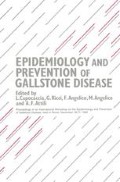Abstract
From a clinical point of view gallstone disease is one of the best-known diseases. Most treatises deal with the clinical aspects of biliary stones in a rather uniform way: i.e., biliary colics and related ‘dyspeptic’ symptoms are commonly associated with stones. Nonetheless, few clinical data1 derived from epidemiological surveys are available. A particular aspect, which may be the most important for a clinician, is represented by asymptomatic gallstones. It is a problem which has drawn the attention of many authors from the very beginning of the study of gallstone disease. It is evident that only an epidemiological study can provide an answer to the problem, though recent papers have largely contributed to improving our knowledge2,3.
For the composition of the Group, see p. xi
Access this chapter
Tax calculation will be finalised at checkout
Purchases are for personal use only
Preview
Unable to display preview. Download preview PDF.
References
Bainton, D., Davies, G. T., Evans, K. T. and Gravelle, I. H. (1976). Gallbladder disease. Prevalence in a South Wales industrial town. N. Engl. J. Med., 294, 1147–1149
Gracie, W. A. and Ransohoff, D. F. (1982). The natural history of silent gallstones: the innocent gallstone is not a myth. N. Engl. J. Med., 307, 798–800
Ransohoff, D. R., Gracie, W. A., Wolfenson, L. B. and Neuhauser, D. (1983). Prophylactic cholecystectomy or expectant management for silent gallstones. Ann. Intern. Med., 99, 199–204
The Rome Group for Epidemiology and Prevention of Cholelithiasis (GREPCO) (1984). Prevalence of gallstone disease in an Italian adult female population. Am. J. Epidemiol. In press).
Remington, R. D. and Schark, M. A. (1970). Statistics with Applications to the Biological and Health Sciences, p. 81. ( Englewood Cliffs, NJ: Prentice-Hall )
Walker, S. H. and Duncan, O. B. (1967). Estimation of probability of an event as a function of several independent variables. Biometrika, 54, 167–179
Author information
Consortia
Editor information
Rights and permissions
Copyright information
© 1984 MTP Press Limited
About this chapter
Cite this chapter
Capocaccia, L., the GREPCO Group. (1984). Clinical symptoms and gallstone disease: lessons from a population study. In: Capocaccia, L., Ricci, G., Angelico, F., Angelico, M., Attili, A.F. (eds) Epidemiology and Prevention of Gallstone Disease. Springer, Dordrecht. https://doi.org/10.1007/978-94-009-5606-3_20
Download citation
DOI: https://doi.org/10.1007/978-94-009-5606-3_20
Publisher Name: Springer, Dordrecht
Print ISBN: 978-94-010-8972-2
Online ISBN: 978-94-009-5606-3
eBook Packages: Springer Book Archive

